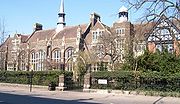_middle_school.gif)
Ashton (VA) Middle School
Encyclopedia
Ashton Middle School is Middle
school in Dunstable
, Bedfordshire
under the Bedfordshire Local Education Authority
Intake comes from a variety of lower schools in the town and surrounding villages. The majority of graduates move up to one of the upper schools in the town - Queensbury School
, Manshead or Northfields
 Ashton’s famous main building and grounds began as Dunstable Grammar School
Ashton’s famous main building and grounds began as Dunstable Grammar School
, founded by Frances Ashton in 1728 and built in 1887. It officially took on its middle school name and status in 1973.
Bedfordshire changed from a two-tier school system to a three-tier system (lower, middle and upper) in 1972 – the concept of middle school originally being mooted in the 1967 Plowden Report
. It is now one of fewer than 400 middle schools in England.
, it is mainly used for Maths and French lessons and secretary duties. It also houses one of two modern IT suites, a matrons office, a library, the main hall and school chapel. The "B" block is primarily for the new intake form classes. The "C" block is multipurpose but includes Science labs and design-technology rooms. The "D" block is used for history, geography and music teaching; and the "E" block contains lockers and storage.
Other facilities include, an Astroturf pitch. There is a PE block with an indoor gym. They have a ball court for the children at break and lunch, also for before school.
Continuous competition exist between the houses including a sports day, swimming gala and merit marks. Also including football, hockey, cricket, rugby, tag rugby, athletics(long jump, high jump, javelin, shot put, and a variety of others), track events. They are currently rebuilding their school garden into a memorial garden dedicated to a former year 8 student, Hayley Spokes.
Middle Schools in England
Middle schools in England are defined in English and Welsh law as being schools in which the age range of pupils taught includes pupils who are aged below 10 years and six months, as well as those who are aged over 12. Such schools were not permitted in the state system under the legislation...
school in Dunstable
Dunstable
Dunstable is a market town and civil parish located in Bedfordshire, England. It lies on the eastward tail spurs of the Chiltern Hills, 30 miles north of London. These geographical features form several steep chalk escarpments most noticeable when approaching Dunstable from the north.-Etymology:In...
, Bedfordshire
Bedfordshire
Bedfordshire is a ceremonial county of historic origin in England that forms part of the East of England region.It borders Cambridgeshire to the north-east, Northamptonshire to the north, Buckinghamshire to the west and Hertfordshire to the south-east....
under the Bedfordshire Local Education Authority
Intake comes from a variety of lower schools in the town and surrounding villages. The majority of graduates move up to one of the upper schools in the town - Queensbury School
Queensbury Upper School
Queensbury Upper School is a mixed, 13-18 upper school and sixth form in Dunstable, Bedfordshire, England. The school has been awarded Specialist Technology College status.- History:...
, Manshead or Northfields
History

Dunstable Grammar School
Dunstable Grammar School was a grammar school in the market town of Dunstable, Bedfordshire, England. Opened in 1888, it was closed in 1971.-Foundation:...
, founded by Frances Ashton in 1728 and built in 1887. It officially took on its middle school name and status in 1973.
Bedfordshire changed from a two-tier school system to a three-tier system (lower, middle and upper) in 1972 – the concept of middle school originally being mooted in the 1967 Plowden Report
Plowden Report
The Plowden Report is the unofficial name for the 1967 report of the Central Advisory Council For Education into Primary education in England. The report, entitled Children and their Primary Schools reviewed Primary education in a wholesale fashion. The collation of the report took around 3 years...
. It is now one of fewer than 400 middle schools in England.
Facilities
It has five buildings, the "A" block being the largest and oldest, situated parallel to Watling StreetWatling Street
Watling Street is the name given to an ancient trackway in England and Wales that was first used by the Britons mainly between the modern cities of Canterbury and St Albans. The Romans later paved the route, part of which is identified on the Antonine Itinerary as Iter III: "Item a Londinio ad...
, it is mainly used for Maths and French lessons and secretary duties. It also houses one of two modern IT suites, a matrons office, a library, the main hall and school chapel. The "B" block is primarily for the new intake form classes. The "C" block is multipurpose but includes Science labs and design-technology rooms. The "D" block is used for history, geography and music teaching; and the "E" block contains lockers and storage.
Other facilities include, an Astroturf pitch. There is a PE block with an indoor gym. They have a ball court for the children at break and lunch, also for before school.
School houses
The school has a house system named after four famous English Cathedrals.| House | Colours |
|---|---|
| Ely | |
| York | |
| Lincoln | |
| Wells |
Continuous competition exist between the houses including a sports day, swimming gala and merit marks. Also including football, hockey, cricket, rugby, tag rugby, athletics(long jump, high jump, javelin, shot put, and a variety of others), track events. They are currently rebuilding their school garden into a memorial garden dedicated to a former year 8 student, Hayley Spokes.

